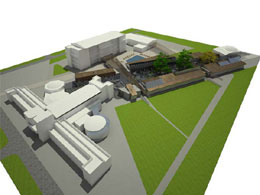STUDENTS PROJECTS
2010
Student : Varsami Natalia
Supervisors: Fani Vavili, Eve Dova
Aristotle University of Thessaloniki, School of Architecture
Date : October of 2009
Abstract:
The project deals with the reconstitution of Lagada's existing thermal facilities and designing new ones that will comply with the latest demands transforming, therefore, the region to a place of attraction. Through the designing process, conventional architecture coexists with contemporary one, achieving, finally, a feeling of natural continuity between the old and the new building complex.

Accompanying text:
Lagada thermal baths are located in a land of 90 acres, 2 km away from Lagada. Mostly therapeutic reasons impel approximately 60000 people per year to visit the hot bath installations.
At the present state, one can notice the outcome of consecutive additions that have reduced the quality of space. Hot bath installations closely surround the Byzantine tubs resulting in the reduction of the monument's reflection.
Aiming to apply rectification measures, previous additions are removed either because of the degeneration of the static system or due to their inability to comply with the proposed designing idea; Problematic spots are also redesigned at the space of hot and sand bath installations.
As far as the new structure is concerned, the inspiration came from the 19th century's "Kurhaus". Therefore, a fusion between high- tech aesthetics and the ancient perception of public thermal baths is being attempted: balneology coexists with entertainment. Nature is the basic element of designing procedure as it contributes in individual's well-being.
The main synthetic idea is to organize the basic activities into a network of closed movements around an atrium. New buildings are designed to follow dynamic linings in the axis of North - South, so as to draw a distinction between old and new structures.
The basic building complexes are connected and the visitor follows a succession of functions, in a simple way and orientation, without loosing any contact with nature.
Despite being independent therapeutic units, each building volume constitutes a part of the whole. The wedge shaped parts, which are formed between the voids, establish both recovery and waiting areas as well as the passage from the main facilities to the hotel and the wedding receptions' room.
The old complex is being attached with the new one through a light construction in distance from the existing building. Glass mediates between the two complexes as a neutral material that does not offend the existing buildings' historical and aesthetic value. New vestry rooms are built in distance from Byzantine tubs leaving a space in between, which becomes an atrium. The latter follows a light construction too and forms a wedge, which connects to the outer buildings. It is constituted by a metal mesh, base of the glass roof that is supported at the side upon the main volumes. In the center, there are glass panels that open to the nature supporting natural ventilation. Random traces conduce to a freeform design for the atrium, in contrast with the existing linear vocabulary, and abide with the rules of nature, reminding a forest. Inside becomes outside.
Referring to the construction of the basic functions, concrete, steel and glass are chosen as the main materials. Each void follows the same constructional method. Steel beams are weld together shaping a standard form. Finally, the materials' choice proves an attempt to maintain a natural continuity between old and new complex, without any dramatic contrasts. Concrete is combined with glass and steel giving a more contemporary character to the architectural synthesis. Yet it is not being used as a structural component any more, rather than a cladding that is supported in the metal skeleton. On the other hand, concrete's strength invites a sense of mysticism (common to the bath architecture through the centuries) and leaves just a few transparent stripes permitting light to come through. This condition is eliminated at the heart of the bath complex through the use of glass and metal. Finally, concrete's roughness brings the users into a condition of existing in nature.










Related articles:
- New functional species ( 29 April, 2012 )
- Facilities of bathing, accommodation and recreation at Molos of Paros ( 17 May, 2014 )
- Εarth & water baths in Mytilene ( 10 February, 2015 )











